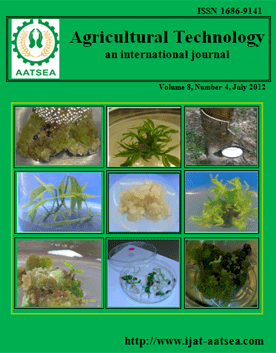ThaiScience
ThaiScience
INTERNATIONAL JOURNAL OF AGRICULTURAL TECHNOLOGY
Volume 15, No. 02, Month MARCH, Year 2019, Pages 319 - 332
Potentially harmful elements in lebanese fattoush salad
Najoie, A., Dani, F., Roger, H., Priscilla, N., Maan, M., Salem, H., Ariadne, A., Efstratios, K., Zacharenia, K., Adil, B. and Elie, A.
Abstract Download PDF
The estimation of potentially harmful element availability in Fattoush ingredients cultivated in Lebanon is essential for evaluating impending risks for human and ecosystem health. In this study and for the first time, the selected plant species were the ingredients of the traditional Lebanese salad, Fattoush, composed of lettuce, cucumber, tomato, onion, purslane, radish, lemon and sumac in order to fulfill all the requirements for the assessment of the contamination levels in vegetables from soils with potentially harmful elements. The major physicochemical properties of topsoil including pH, organic matter content and texture showed that studied soils were almost neutral pH of 7.0, very poor in organic matter (organic matter percent ˂0.05 %) and sandy respectively(based on soil texture triangle). Concentration ranges of As, Cu, Fe, Zn, Mn, Ni, V, Cd, Co, Cr, Pb, P, Sn and Al in soils and edible parts of plants collected from urban allotments in the South, Damour, Ghazir and Akkar areas were determined and assessed by Inductively Coupled Plasma Optical Emission Spectroscopy following microwave assisted digestion by HNO3/H2O2. Also, weak acetic acid digestion and aqua regia digestion were similarly measured following microwave assisted digestion. Transfer factors from sandy soils to vegetables because of their health risk were calculated accordingly. Results showed that concentrations of most of studied elements in soil and plant samples were recorded above the permissible limits set by World Health Organization especially in purslane, lemon and sumac. For this reason, amounts of accumulated Cu, Fe, Zn, Mn, Ni and V in the studied plant – soil systems (mg/kg) were separately shown. Furthermore, the sumac, purslane, lemon and lettuce plants were found to be “heavy metal hyperaccumulating plants”. Finally, soil to plant transfer is the major path way of human exposure to PHEs contamination and safety measurements should be strictly applied.
Keywords
pseudototal, mobilizable, assisted digestion, aqua regia, transfer factorINTERNATIONAL JOURNAL OF AGRICULTURAL TECHNOLOGY
Published by : Association of Agricultural Technology in Southeast Asia (AATSEA)
Contributions welcome at : http://www.ijat-aatsea.com
